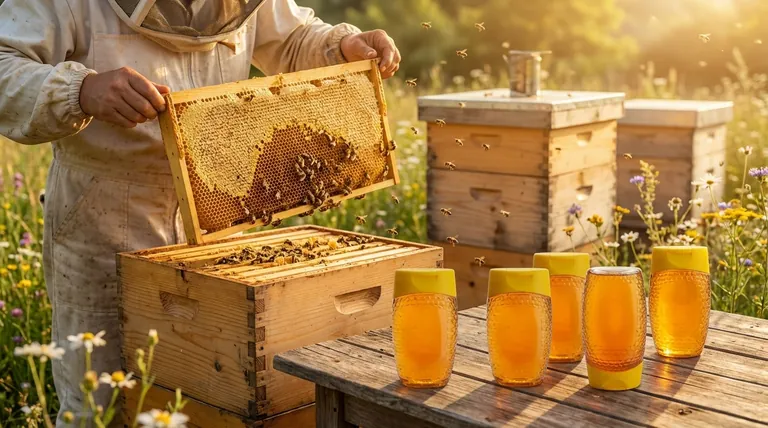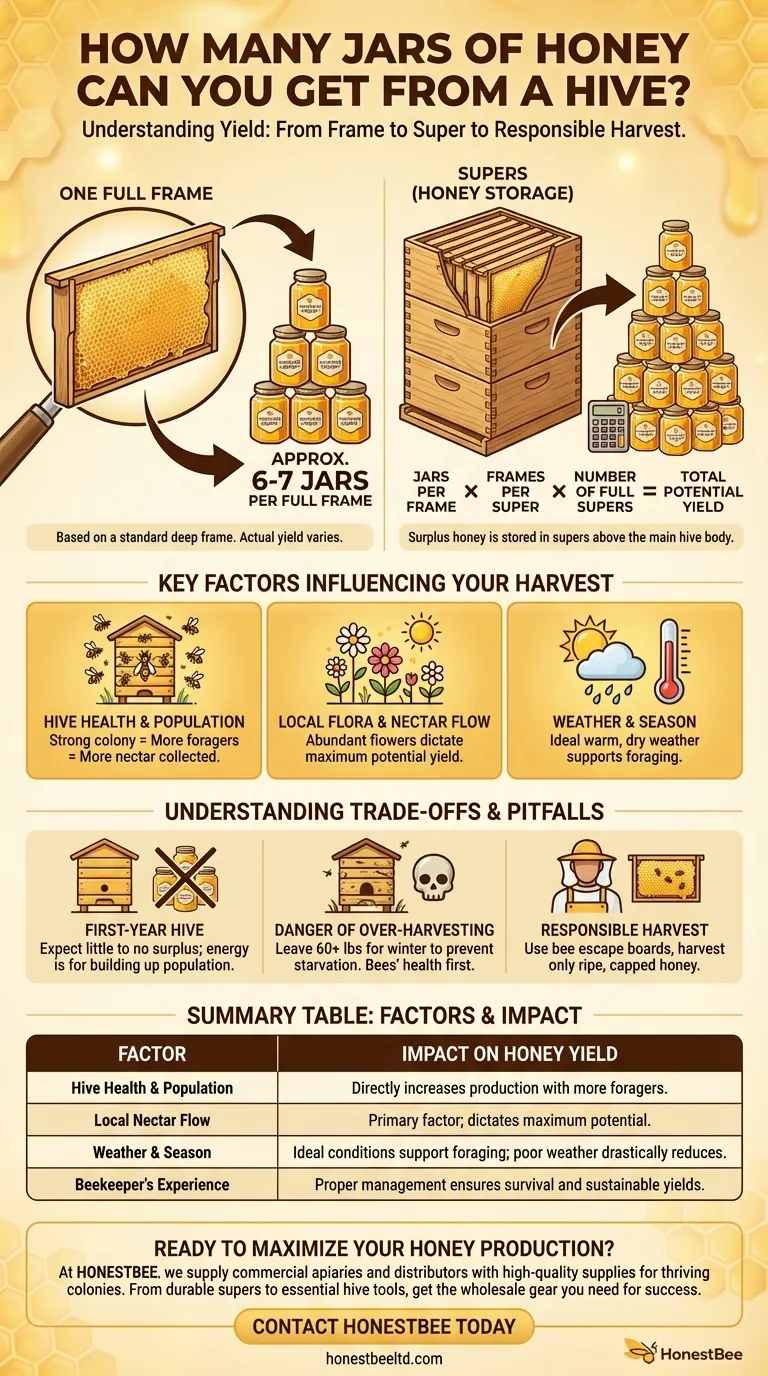The short answer is that a single, full frame of honey from a beehive can yield approximately six to seven standard jars. A beekeeper might harvest multiple frames from several boxes (called "supers") on a strong hive, but the total amount is highly dependent on the hive's health, the weather, and the local environment.
A beehive's honey yield isn't a fixed number; it's a direct reflection of the colony's strength, the available nectar, and the beekeeper's management style. Understanding the variables is far more important than chasing a specific number of jars.

Deconstructing the Hive: From Frame to Jar
To understand the potential yield of a hive, you first need to understand its basic components. The final number of jars is a simple calculation based on these parts.
The Frame: The Basic Unit of Honey
A frame is a single, removable rectangular structure inside the hive where bees build their wax honeycomb. They use the cells of this comb to store honey.
A single deep frame, when completely full and capped with wax, holds a significant amount of honey. As a reliable estimate, you can expect to get six or seven jars from one full frame.
The Super: The Honey Storage Box
A "super" is simply a box that contains multiple frames (typically eight or ten). Beekeepers place these boxes on top of the main hive body where the queen lays her eggs.
The bees will fill the main hive with the resources they need to live and then store any surplus honey in the frames within these supers. A harvestable yield comes exclusively from these supers.
Calculating Your Total Potential
The math for estimating a harvest is straightforward: (Jars per Frame) x (Frames per Super) x (Number of Full Supers) = Total Yield.
A strong hive in a great location might fill two, three, or even more supers in a good year, leading to a very large harvest. A weaker hive might not produce any surplus honey at all.
Key Factors Influencing Your Honey Harvest
No two hives will produce the same amount of honey, even in the same apiary. Production is a sensitive indicator of several critical, fluctuating conditions.
Hive Health and Population
A large, thriving colony with a healthy queen will have many more forager bees than a small or struggling colony. More foragers mean more nectar can be collected, leading directly to more honey.
Local Flora and "Nectar Flow"
The single most important factor is the "nectar flow"—the period when major nectar-producing plants are in bloom. The type, quantity, and quality of flowers in a multi-mile radius of the hive determine its maximum potential.
Weather and Season
Bees don't fly in cold or rainy weather. A season with perfect conditions can lead to a massive harvest, while a year with a late spring, drought, or excessive rain can result in almost no surplus honey.
Understanding the Trade-offs and Common Pitfalls
New beekeepers often have misconceptions about honey yield. Avoiding these common pitfalls is crucial for the long-term health of your colony.
The "First-Year Hive" Mistake
Do not expect a significant honey harvest, if any, from a hive in its first year. The colony will dedicate nearly all its energy to building up its population, drawing out fresh wax comb, and storing enough resources for its own survival.
The Danger of Over-Harvesting
A beekeeper's primary responsibility is to the health of the bees. Bees need a substantial amount of honey (often 60+ pounds) to survive the winter. Taking too much can lead to starvation and the death of the colony. Always leave them more than you think they'll need.
The Process of a Responsible Harvest
A responsible harvest involves a clear process. Beekeepers first identify frames with ripe, "capped" honey, where bees have sealed the cells with wax.
Using a tool like a bee escape board, they can gently clear the bees from the supers without chemicals. The frames are then uncapped, the honey is extracted, and the empty combs are returned to the hive for the bees to reuse.
Making the Right Choice for Your Goal
Your approach to harvesting should align with your primary goal as a beekeeper.
- If your primary focus is hive health and sustainability: Only harvest from supers that are well and truly surplus, and always ensure the colony has more than enough stores to survive winter.
- If your primary focus is a modest personal supply: Consider harvesting just a few full frames at a time. This is less disruptive and allows you to leave the rest for the bees.
- If your primary focus is maximizing yield: Concentrate on managing strong, healthy colonies and deeply understanding your local nectar flows to ensure supers are available exactly when the bees need them.
Ultimately, successful beekeeping measures its rewards not just in jars of honey, but in the health and vitality of the colony itself.
Summary Table:
| Factor | Impact on Honey Yield |
|---|---|
| Hive Health & Population | A strong, healthy colony has more foragers, directly increasing honey production. |
| Local Nectar Flow | The primary factor; the abundance of blooming flowers dictates maximum potential yield. |
| Weather & Season | Ideal conditions (warm, dry) support foraging; poor weather can drastically reduce harvests. |
| Beekeeper's Experience | Proper management, like not over-harvesting, ensures colony survival and sustainable yields. |
Ready to maximize your honey production? A reliable harvest starts with strong, healthy hives. At HONESTBEE, we supply commercial apiaries and beekeeping equipment distributors with the high-quality supplies and equipment needed to build and maintain thriving colonies. From durable supers and frames to essential hive tools, our wholesale-focused operations ensure you get the gear you need for success.
Contact HONESTBEE today to discuss how our products can support your beekeeping goals and help you achieve a more productive and sustainable harvest.
Visual Guide

Related Products
- Inverted Squeezable Honey Jar with No Drip Flip Top Cap for Easy Pouring
- Professional Cone-Shaped Honey Filter with Reinforced Steel Ring
- 6 Frame Manual Stainless Steel Honey Extractor Beekeeping Equipment
- 10L Stainless Steel Electric Honey Press Machine
- Honey Gate Valve with Ergonomic Ball Handle Plastic Bee Honey Tap for Beekeeping Bottling and Honey Extractor Equipment
People Also Ask
- How long to let honey settle before bottling? Achieve Crystal-Clear Honey for a Premium Product
- How should honey bottles be prepared before pouring honey into them? The #1 Rule for Honey Longevity
- Can honey go bad in the heat? Protect Your Honey's Quality and Flavor
- What causes honey to crystallize? A Guide to Natural, High-Quality Honey
- How should honey be stored and packaged? Preserve Flavor & Quality with Proper Containers



















